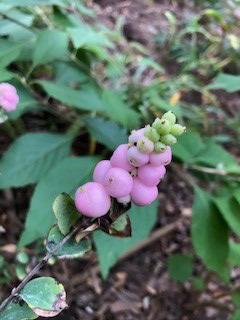Maryland and Virginia Native Shrubs: What to Prune Right Now!
- Nuts for Natives
- Mar 31, 2021
- 3 min read
Beautyberry, coralberry, wild hydrangea and red twig dogwood, we are looking at you.

A handful of native shrubs really benefit from an early spring pruning. If you grow native beautyberry, coralberry, wild hydrangea or red twig dogwood, now is just the time! It will take you only a few minutes to prune each shrub and make a world of difference.
Beautyberry, coralberry and wild hydrangea all bloom on wood that grows during the current season, or "new wood." Cutting them back now will generate more blooms, more berries and a more organized shape to your shrubs. Red twig dogwood generates the reddest winter color on younger stems. Pruning encourages new stems.
Beautyberry
Beautyberry (Callicarpa Americana), with its purple fruit shine in fall just when our gardens and birds need it. Without pruning, these shrubs can grow in a fairly haphazard manner such as the middle photo above. Cutting them back now will encourage new growth to be a bit more uniform like the shrub on the right.
You can prune every stem back to a foot or so. It's hard to see in this photo but the young beautyberry shrub on the left produced numerous branches with berries last season and has just been cut back to one foot this spring. It looks severe but it will grow back even better.
Coralberry
Coralberry (Symphoricarpos orbiculatis) is grown primarily for its pink berries in fall. Spring pruning will encourage growth and more berries. You can prune the entire shrub back to about a foot or so in height.
The four foot high coralberry on the left has just begin to green up. On the right, it has been pruned to about a foot in height. This will encourage more new growth and berries during the coming growing season.
Wild Hydrangea
Wild Hydrangea (Hydrangea arborescens)
Wild hydrangea, above on the left, produces flowers on new growth. The stems can be floppy. Pruning will encourage much sturdier stems. This also applies to the very common cultivar of wild hydrangea, Hydrangea Arborescens "Anabelle" above on the right. If you are unsure of the important difference between the two, please check out this post.
Prune every stem back to about a foot in height shown above right. It's best to make a cut just above a leaf bud. I hesitated to prune wild hydrangea for the longest time and every year, I got fewer and fewer flowers and the stems were floppier and floppier. Once I started pruning each spring, the plants produced many more flowers and the stems were more upright.
Please note, this type of spring pruning is not recommended for the other native hydrangea, oakleaf hydrangea. Oakleaf hydrangea blooms on old wood. My mnemonic device -- Oakleaf/Old wood. Any pruning you do now, may cut off the coming summer's flowers.
Red Twig Dogwood
Red Twig Dogwood (Cornus sericea) can be pruned in fall, winter or spring to remove older stems which encourages new stems to form. Newer stems have the brightest red colors in winter. Since many of us grow this shrub for the winter color, pruning regularly will help you get the best color. If you already did this last fall, or over the winter, you are set. If not, now is a good time. It's easier to identify the oldest stems before the shrub leafs out.
The older stems are browner in color like those at the back of the center photo above. The redder stems in front are younger. Remove the oldest stems at the base of the shrub. A basic pruning rule of thumb is you can safely remove up to 1/3 of the stems without damaging the shrub. That said, I do know gardeners who prefer to keep the shrub small and prune the entire shrub back to about a foot each spring and it will likely be just fine. I would not do that to a newly planted shrub though.
Prepare to prune to prime these shrubs to perform!















































Comments